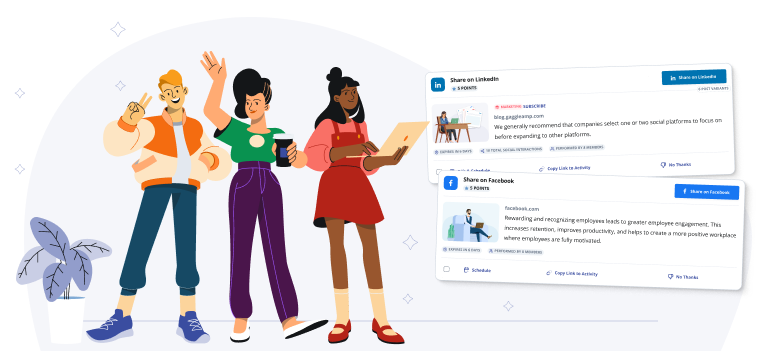8 Key Benefits of Employee Engagement You Need To Know
Stakeholders and executives usually agree that employee engagement is important, but they rarely realize how much it impacts the company's bottom line.
As a result, employee engagement initiatives are seldom a top company priority, making it difficult to secure a budget for an employee engagement program.
In addition, if leadership doesn't fully believe in the importance of employee advocacy, employees will also assume that participation isn't essential.
As a result, you'll find it more difficult to keep employees engaged, and you might be discouraged by subpar results.
To help you win buy-in from leadership for your employee engagement program, here are eight key benefits that demonstrate the impact of employee engagement plus how to improve employee engagement.
Why Is Employee Engagement Important
The company's product/service is ultimately the result of its employees' combined efforts.
However, the degree to which employees work together is a major variable that significantly impacts everything from how fast you ship products to the customer experience that you deliver.
Most leaders agree that disengagement hinders productivity, but few realize that while employees who do their jobs well individually can produce steady company growth, actively engaged employees can produce outsized returns.
Steven R. Covey defined this well in his book called The 7 Habits of Highly Effective People.
Specifically, he said, "Interdependent people combine their own efforts with the efforts of others to achieve their greatest success."
As you can see, producing outsized returns with fewer employees and resources is the goal of every executive.
Below, we’ll discuss some of the specific benefits of employee engagement that you can use to win buy-in from your leadership team.
The 8 Main Benefits of Employee Engagement
So, why is employee engagement important to HR and the rest of the company?
A study by Gallup showed that companies with the highest employee engagement rates were 21% more profitable than companies with average engagement rates.
The bigger question is why companies with engaged employees are more profitable. Below, we'll dive into eight specific benefits of employee engagement that contribute to improved profitability.
1. Reduces Employee Turnover
Replacing employees is expensive. In fact, statistics suggest that it generally costs 50%-60% of that employee's salary to replace them, though the overall costs to the company (factoring in opportunity costs, etc.) can range from 90%-200%.
The good news is that increasing employee engagement can significantly reduce employee turnover. In fact, one study showed that companies that scored in the top 20% for employee engagement saw 59% less turnover than their counterparts.
Another study showed that only 30% of actively engaged employees are currently looking for new job opportunities while 74% of disengaged employees are actively looking for new opportunities.
Improving employee engagement can significantly reduce employee turnover costs.
To prove the importance of employee engagement to leadership, take your current employee turnover rate and show them the financial impact of reducing it by 59%. That number will make it much easier for leadership to justify allocating budget to your employee engagement program.
2. Attracts Top Talent
Highly engaged employees tend to be happier employees. When your employees' friends see how happy your employees are, those friends often naturally ask about open positions at the company.
As a result, the company can acquire top talent at a fraction of the cost, as it won't have to pay a recruiter to find candidates. In addition, employee referrals tend to be the highest quality candidates, so you'll also get higher quality talent than those sent through a recruiter.
Engaged employees are also more likely to actively recruit great talent by posting on social media. Here's a great example from Crumbl Cookies:
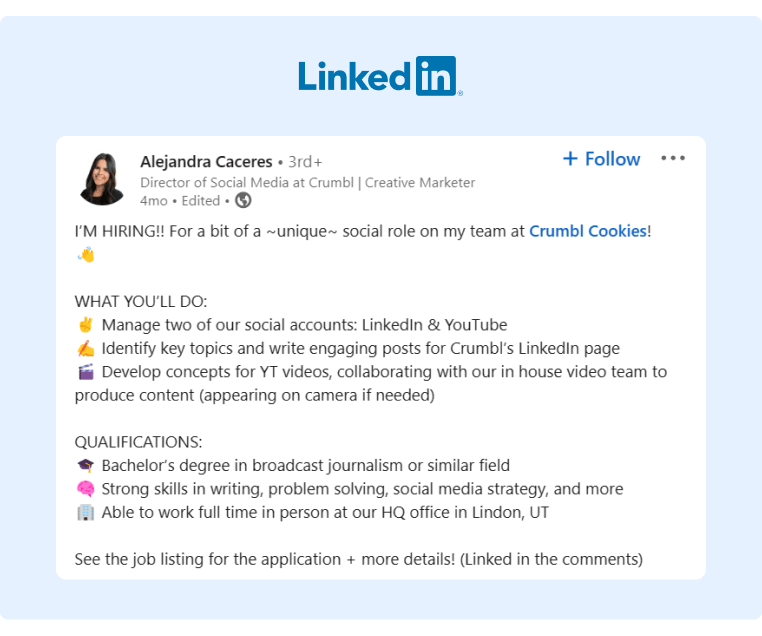
Source: Alejandra Caceres
You can also tell from the comments that the brand has done an excellent job crafting an enviable culture:
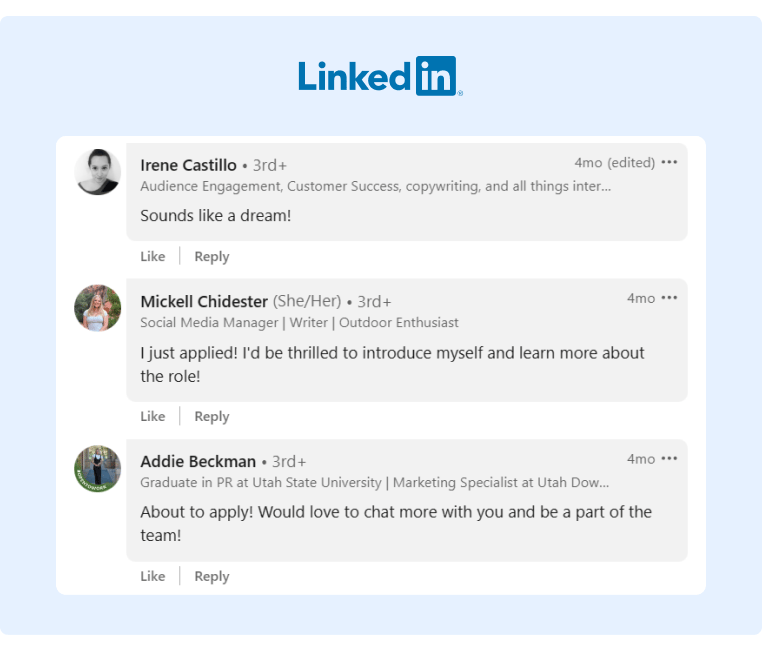
Source: Alejandra Caceres
3. Improves Employee Productivity
Studies show that engaged employees are 17% more productive than disengaged workers and produce 3.9 times higher earnings per share than disengaged employees.
This makes sense as engaged employees are more likely to communicate with one another more frequently. As a result, they'll be well aligned on projects, reducing the risk that employees will have to redo work or that multiple people will do the same tasks.
Employees who are happy and communicate frequently are also more likely to have better relationships with one another. If a conflict arises, they'll confront and resolve the issue quickly before it escalates, which significantly improves the company's execution speed.
As a result, the company will ship products faster, resolve customer complaints more quickly, and stay ahead of the competition.
Improving individual employee productivity also allows the company to operate with a leaner team.
4. Increases Brand Awareness
Engaged employees are also more likely to discuss what they're working on with their friends in conversation and on social media.
Here's a great example of this in action:

Source: Amelia Foard
As a result, you'll organically increase brand awareness, contributing to several other goals, like reducing customer acquisition and marketing costs.
You can further improve employee involvement and participation on social media by implementing an employee advocacy program that instructs employees on effectively engaging on social media in a way that amplifies brand awareness.
Some studies suggest that employee advocacy increases total brand reach by up to 561%, and content shared from employee accounts receives eight times more engagement than content published on brand channels.
An additional benefit of employee advocacy is that it connects your brand with a warm audience. Unlike paid advertising, where you'll have to spend time (and marketing dollars) to earn their trust, leveraging your employees' networks will help you reach a warm audience, making it easier to close those prospects faster.
5. Strengthens Company Culture
Smaller teams are known for having a stronger company culture, as it's easier to stay aligned on core values, mission, and vision when team members talk to one another daily. People also absorb the habits and mannerisms of the co-workers they spend time with, so it's easy to mold new hires to the company culture by simply interacting with them daily.
As companies grow, the culture often suffers because teams become their own units with separate agendas and ideas.
The good news is that implementing an employee engagement strategy can strengthen company culture by encouraging employees from different departments to communicate with one another. This makes it easy for everyone to stay aligned on the core mission and vision of the company.
For example, HubSpot has won numerous culture awards, and a key to its success is its strong employee engagement program. For example, one engagement initiative it offers is the employee nomination bonus. Each quarter, employees can nominate a co-worker who helped them in some capacity for a monetary bonus. This helps strengthen relationships among co-workers and increases gratitude, all of which lead to a stronger company culture.
6. Improves Brand Sentiment
Engaged employees are also happier as they're more involved in the company's mission. Therefore, they're more likely to speak positively about the company around friends and family and on social media.
Here's a great example of a highly engaged Univar Solutions employee who posted on social media about going to Disney to celebrate two great years with Univar Solutions:
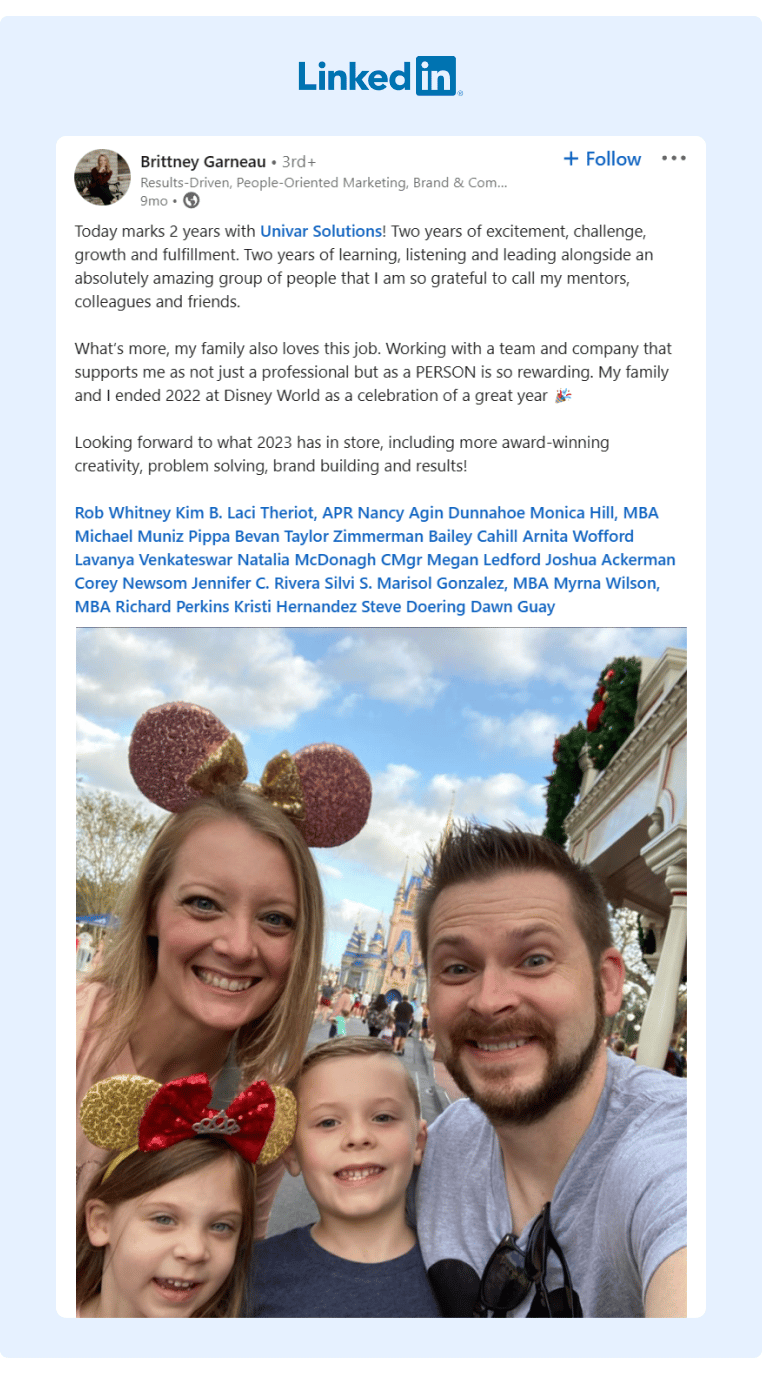
Source: Brittney Garneau
A post like the one above adds to Univar Solutions positive brand sentiment and increases brand loyalty from customers.
7. Elevates Customer Satisfaction
As a consumer, you can tell when an employee is simply doing their job and when they genuinely love the company they work for.
The employees who love their company are usually more positive and think outside the box to solve customer challenges.
However, it isn't just customer service representatives that impact the customer experience.
For example, a highly engaged content marketer will likely produce higher quality content, which in turn results in a better reader experience and more leads.
Similarly, a highly engaged developer committed to the company's success will go the extra mile to ensure the product fully solves the customer's pain points. They will also likely triple-check for bugs and errors.
There's also plenty to research to support this logic. A study of a call center showed that disengaged employees make 41% more mistakes than engaged employees, which negatively impacts the customer experience and, ultimately, the company's bottom line.
8. Reduces Employee Absenteeism
A Gallup study found that engaged employees have an 81% lower absenteeism rate than their disengaged peers.
This is likely because engaged employees tend to be more motivated by the company mission and therefore take personal responsibility to tackle challenges rather than avoiding them.
Happy and engaged employees are also more likely to attend work simply because they find it more enjoyable than demotivated and disengaged employees.
How To Improve Employee Engagement
Now that you know the benefits of employee engagement, how do you meaningfully improve it across an organization?
While we have a list of various employee engagement activities you can implement, our favorite strategy is leveraging employee advocacy.
When your employees share what they're working on with the rest of their network, they take more ownership and pride in their work. In addition, other co-workers usually join the conversation on social media, strengthening team relationships.
Employee advocacy also provides additional external benefits to the brand, like increased brand awareness, sentiment, and customer loyalty.
The only tricky aspect of employee advocacy is keeping employees engaged for an extended period of time.
Employees want to see the company succeed, but they also have plenty of other high-value tasks to complete, and employee advocacy can easily fall off their list of priorities.
We found that the key to improving employee engagement and creating a sustainable employee advocacy program is reducing the time and effort required for employees to participate.
Many employees don't know what content to share or what to write, which deters them from engaging altogether. Employees may also worry they'll say something off-brand that could get them in trouble with their manager. There's also the reality that employees get busy and simply forget to engage.
Unfortunately, it's incredibly time-consuming (and unrealistic) for marketing managers to send specific engagement instructions to each individual employee.
To solve these problems, we created an employee advocacy platform, GaggleAMP, that allows managers to create and assign engagement activities – complete with pre-written text – at scale.
Below we'll provide an overview of how this works.
Step 1: Managers Select Specific Engagement Activities
The first reason many employees never participate in employee advocacy programs is that they don't know what content to engage with or what they should say.
It's impractical for you to personally message each employee with specific engagement activities and a detailed explanation of exactly what they should say.
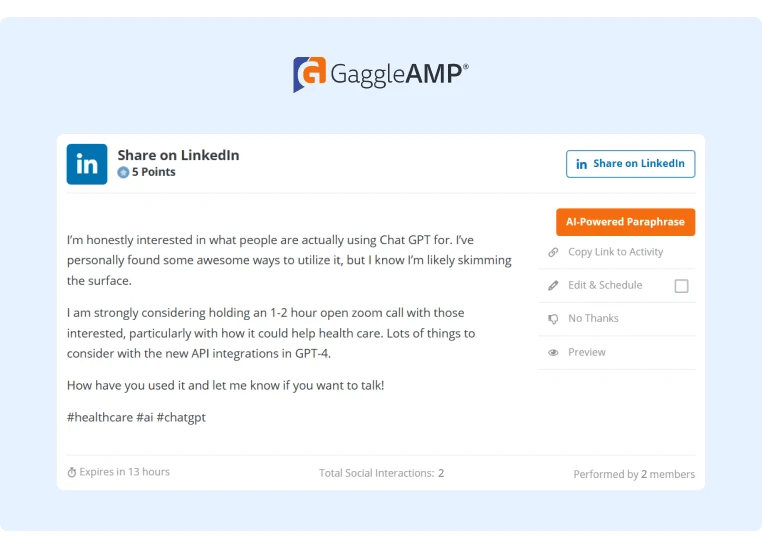
GaggleAMP solves this problem.
First, select one of GaggleAMP's engagement activities. Each engagement activity specifies the platform the employee should engage on (LinkedIn, X (formerly Twitter), Facebook, etc.) and the specific engagement action (like, share, comment, etc.).
Employees appreciate the specificity since it's one less decision they must make to participate in your advocacy program.
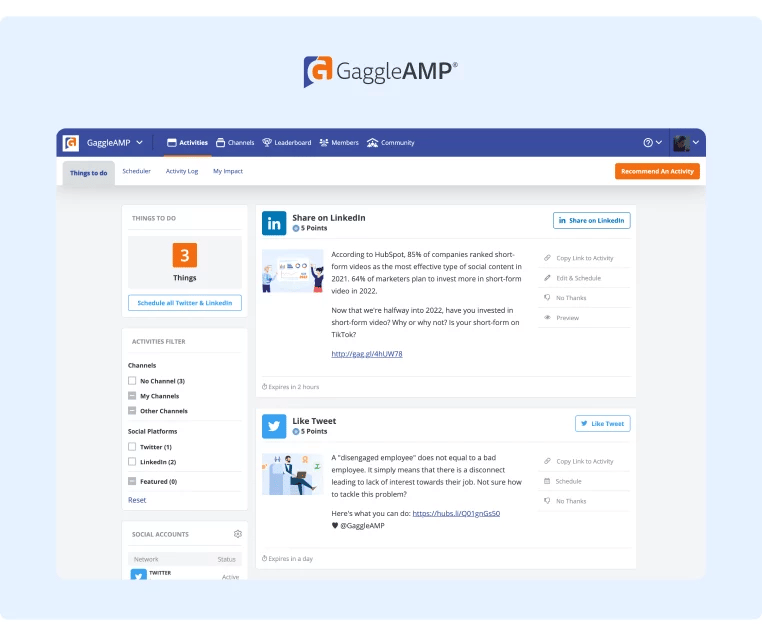
We also realized that many employees don’t engage because they simply don’t know what to say. Therefore, GaggleAMP also has an AI-Powered Paraphrase tool that makes it easy for you as a manager to create pre-written text for employees.
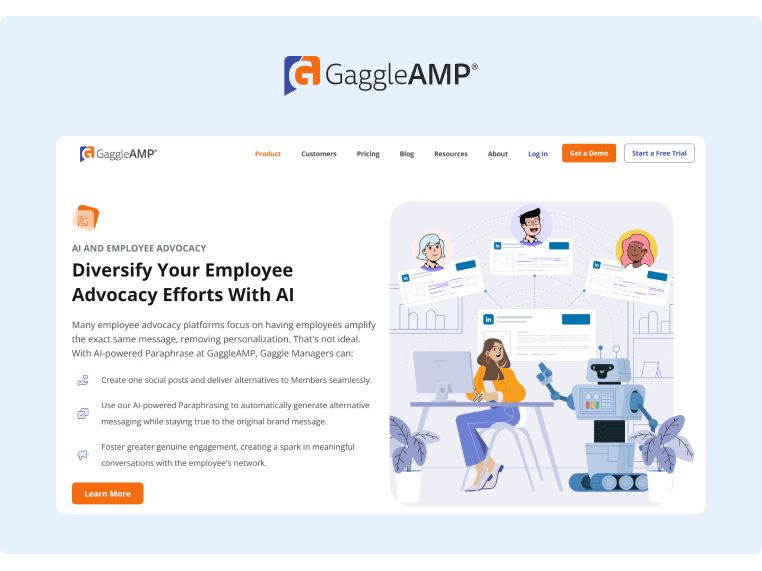
This way, employees just have to log into the platform, approve or edit the text, and then schedule it for publishing at a later date.
By significantly reducing the time and effort required from employees to participate in your employee advocacy program, you can meaningfully increase engagement rates and keep employees engaged for an extended period of time.
Step 2: Managers Assign Engagement Activities to Employees
Once you've created the engagement activity, you can assign it to a group of employees (like executives, the marketing team, etc.) or a specific employee.
This allows you to assign personalized engagement activities to employees at scale without sending endless customized messages.
Step 3: Employees Approve and Schedule Activities
Once you assign an engagement activity, employees receive a notification (via Slack, Microsoft Teams, or email) that they have an engagement activity waiting. They can then log into their personal Gaggle to view and complete their engagement activities.
If you've already added pre-written text for them with the AI-Powered Paraphrase tool, employees can simply edit, approve, and schedule the content to be published at a future date. You can also enable the Member's ability to paraphrase their own content. This way you know it’s all truly unique.
Using this process, employees can reduce the time they devote to employee advocacy from several hours to a few minutes per month. They also don't have to draft thoughtful comments from scratch.
As a result, most employees are more than happy to contribute to frequently engage with your employee advocacy program.
Step 4: Manager Track Results and Reward Engagement
Finally, it’s important to measure the impact of employee engagement so that you can continue to win buy-in from leadership.
Therefore, GaggleAMP offers an analytics dashboard that provides metrics like:
- Total reach.
- Total engagement activities created (by managers).
- Total engagement activities completed (by employees).
- Total clicks.
- Estimated earned media value.
For each metric, you can drill down by campaign or employee to identify patterns that led to high engagement.
It also offers benchmarking metrics so that you can gauge your program's success based on other similar sized programs.
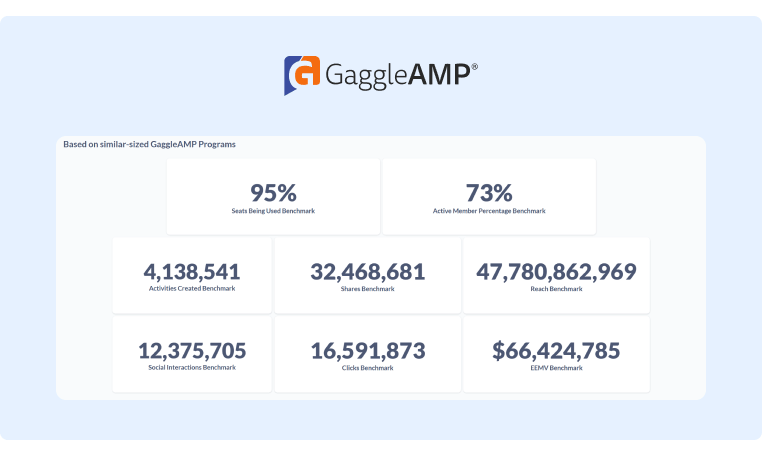
Finally, GaggleAMP offers a public leaderboard that ranks employees by engagement to further encourage program participation.
Here's how it works.
When you assign an engagement activity, you can assign a specific number of points to that engagement activity. When employees complete the activity, they earn the associated points.
Then, the public leaderboard ranks employees by point total.
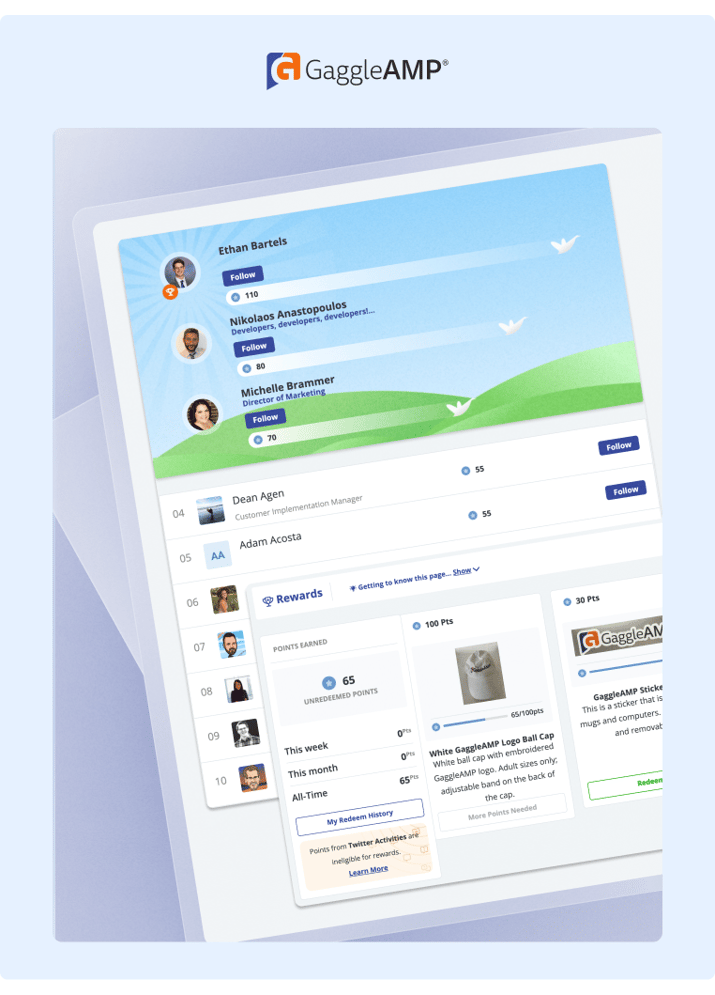
At the end of the quarter, you can reward the highest-ranked employees with an Amazon gift card or bonus. Alternatively, you can simply award a bonus to employees who earn above a certain point total.
This allows you to recognize and appreciate employees for their efforts, and it also adds friendly competition, further encouraging employee engagement.
You can learn more about GaggleAMP and how it works by scheduling a demo or exploring the product features.
Start Your Employee Engagement Program Today
The benefits of employee engagement aren’t just for enhancing the employee experience. Improving employee involvement and participation is critical for companies that want to improve their bottom line and cultivate a strong culture.
If you’re struggling to get buy-in from executives, use the benefits and statistics in this article to craft a compelling pitch.
Alternatively, if you’re ready to start building your employee engagement program, here’s a guide to various employee engagement strategies you can implement now. You can also simply adopt an employee advocacy program, as we’ve found that employee advocacy is the 80/20 of employee engagement.
You can learn more about employee advocacy by talking to the GaggleAMP team today.







